To shoot stunning drone videos of high-end resorts, start by selecting a drone with a 4K camera and 3-axis gimbal for smooth footage. Obtain necessary permits and scout locations beforehand. Plan your shots to showcase the resort's best features, including aerial establishing shots and close-ups of amenities. Film during golden hour for ideal lighting, and use ND filters for enhanced quality. Incorporate various shot types and smooth movements for cinematic appeal. In post-production, apply color grading to enhance the luxury feel. Remember to respect local regulations and resort policies throughout the process. Mastering these techniques will elevate your resort drone videography to new heights.
Choosing the Right Drone
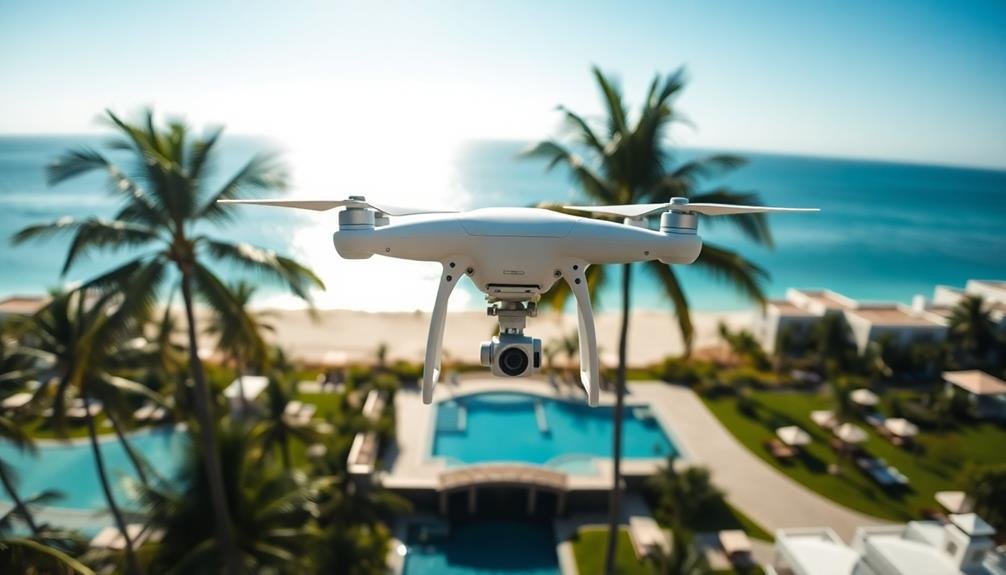
Often, the first step to shooting stunning drone videos is selecting the right equipment. For high-end resort footage, you'll want a drone that offers exceptional image quality, stability, and flight performance.
Look for models with at least a 4K camera and a 3-axis gimbal for smooth, professional-looking shots. Consider drones with intelligent flight modes, such as waypoints and orbit, which can help you capture cinematic sweeping shots of the resort's landscape.
Obstacle avoidance technology is essential when flying near buildings and trees. Battery life is also important; aim for at least 25-30 minutes of flight time per charge.
Don't forget about portability. You'll want a drone that's easy to transport and set up quickly. Foldable designs are ideal for travel.
Consider the drone's noise level too, as quieter models are less likely to disturb resort guests.
Essential Equipment for Resort Filming
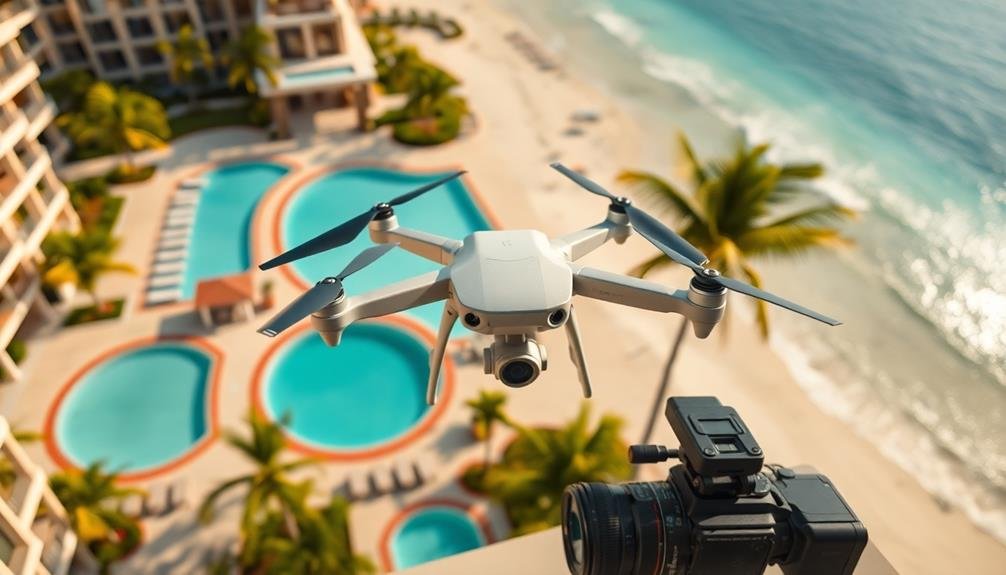
When filming resorts with drones, you'll need more than just a flying camera.
Start with a high-quality drone that offers stable flight and excellent video capabilities.
Pair your drone with specialized camera equipment like ND filters and gimbal stabilizers, and don't forget essential accessories such as extra batteries, propellers, and a sturdy carrying case.
High-Quality Drone Selection
To capture breathtaking resort footage, selecting the right drone is essential. You'll want to invest in a high-quality model that offers stability, long flight time, and excellent camera capabilities. Look for drones with at least a 4K camera and a 3-axis gimbal for smooth, professional-looking shots.
Consider models like the DJI Mavic 3 or Autel EVO II Pro, which offer impressive flight performance and image quality. These drones provide extended flight times of 30+ minutes, allowing you to capture more footage in a single session. They also feature obstacle avoidance systems, vital for maneuvering around resort structures safely.
Ensure your chosen drone has a reliable transmission system for maintaining a strong connection with the controller. This is particularly important when filming large resort properties.
Additionally, select a drone with intelligent flight modes like waypoints or orbit, which can help you create dynamic shots of resort amenities.
Don't forget to check local regulations regarding drone use in your filming location. Some resorts may have specific policies or restricted areas.
Always prioritize safety and respect for guests' privacy when operating your drone around the property.
Specialized Camera Equipment
Drone-specific accessories can considerably enhance your resort filming capabilities. To capture stunning footage of high-end resorts, you'll need more than just a basic drone setup.
Invest in a high-quality gimbal stabilizer to guarantee smooth, professional-looking shots even in windy conditions. This essential piece of equipment will help you achieve cinematic pans and sweeping views of the resort's landscape.
Consider adding ND (Neutral Density) filters to your camera arsenal. These filters allow you to control light exposure, particularly useful when shooting bright, sun-drenched resort exteriors.
They'll help you maintain proper shutter speeds and achieve that coveted cinematic look.
Don't forget about memory cards. Opt for high-speed, high-capacity cards to handle the large file sizes of 4K or even 8K video.
You'll want to capture as much footage as possible without interruption.
For extended filming sessions, invest in extra batteries and a portable charging station. This will keep you airborne longer, allowing you to capture those perfect golden hour shots or sunrise-to-sunset timelapses of the resort.
Lastly, consider a reliable FPV (First Person View) monitor with a sun hood. This will help you see your drone's live feed clearly, even in bright sunlight, guaranteeing you don't miss any spectacular resort views.
Essential Accessories
Beyond the drone itself, certain accessories are essential for capturing stunning resort footage. First, invest in high-quality, fast SD cards to guarantee smooth recording of 4K video without dropped frames.
You'll need multiple batteries to extend your flight time, allowing for thorough coverage of expansive resort properties. A portable charging hub is important for keeping your batteries topped up between flights.
To protect your equipment during transport, a sturdy carrying case is necessary. Look for one with customizable foam inserts to securely hold your drone, controller, and accessories.
ND filters are crucial for controlling exposure in bright sunlight, common at tropical resorts. They'll help you maintain the desired shutter speed for cinematic motion blur.
A tablet mount for your controller enhances visibility and control, especially when flying in bright conditions. Consider a signal booster to extend your drone's range, particularly useful for sweeping coastal shots.
Obtaining Necessary Permits
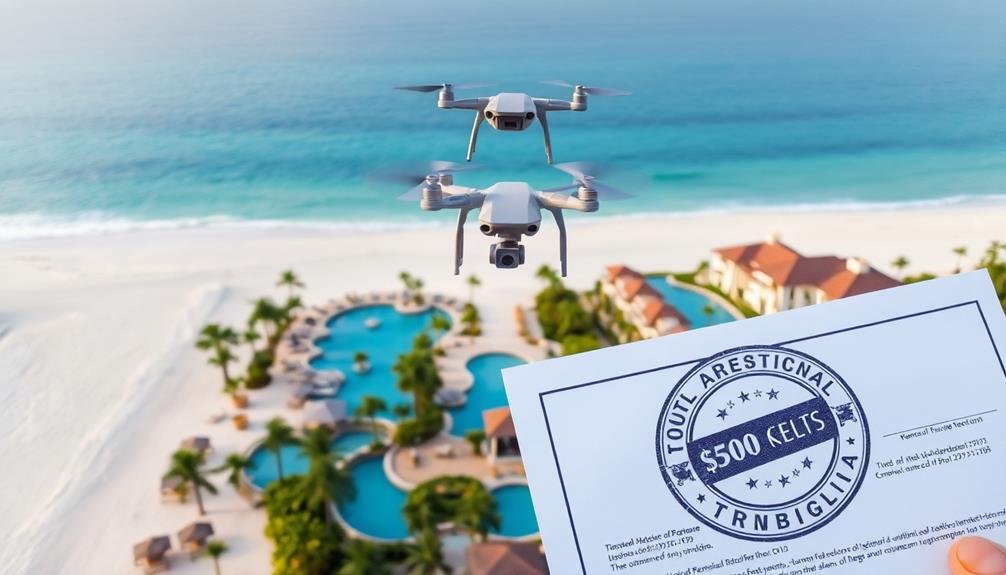
Before taking to the skies with your drone, you'll need to secure the necessary permits and licenses. Start by obtaining your Remote Pilot Certificate from the Federal Aviation Administration (FAA). This involves passing an aeronautical knowledge test and registering your drone. For commercial operations, you'll also need to comply with Part 107 regulations.
Next, contact the resort's management to obtain written permission for drone filming on their property. They may have specific requirements or restricted areas.
Check local regulations, as some municipalities have additional drone laws. If you're flying near airports or in controlled airspace, you'll need to request authorization through the FAA's LAANC system.
For international resorts, research the drone laws of the country you'll be visiting. Some nations require temporary import permits or have strict no-fly zones.
Don't forget to secure insurance coverage for your drone operations, which may be required by the resort or local authorities.
Lastly, if you plan to use the footage commercially, confirm you have the necessary releases and agreements in place with the resort and any identifiable individuals in your shots.
Scouting Locations
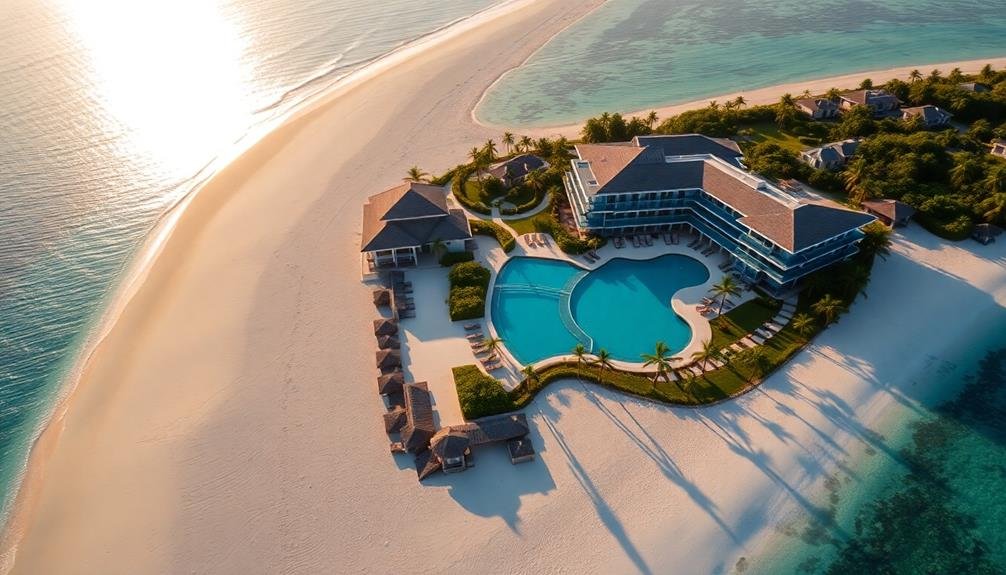
Before you head out with your drone, conduct thorough online research to identify potential filming locations and understand any restrictions or notable features.
Once on-site, assess the area for obstacles, lighting conditions, and unique visual elements that could enhance your footage.
Don't forget to take into account different times of day and weather conditions that might impact your shoot.
Pre-Visit Research Techniques
In advance of your drone shoot, thorough location scouting is essential for capturing stunning aerial footage. Before visiting the resort, leverage online resources to gather significant information.
Start by examining satellite imagery and topographical maps to understand the landscape and identify potential vantage points. Use Google Earth to virtually explore the area, noting interesting features and possible flight paths.
Research local weather patterns and sunrise/sunset times to plan for ideal lighting conditions. Check the resort's website and social media accounts for recent photos and videos, which can inspire shot ideas and reveal popular areas.
Look for any unique architectural elements or amenities that could make for compelling aerial footage.
Don't forget to investigate local drone regulations and no-fly zones. Contact the resort management to obtain necessary permissions and inquire about any specific guidelines or restrictions.
Research nearby airports or helipads that might affect your flight plans.
On-Site Location Assessment
With your pre-visit research complete, it's time to evaluate the location in person. Arrive early to scout the resort thoroughly, identifying key features and potential filming spots. Walk the grounds, noting scenic vistas, unique architectural elements, and guest amenities. Pay attention to lighting conditions at different times of day, and consider how they'll affect your footage.
During your evaluation, create a shot list and flight plan. Identify takeoff and landing zones, ensuring they're clear of obstacles and away from guest areas. Be aware of no-fly zones, privacy concerns, and any local regulations that may affect your drone operations.
Use this table to guide your on-site evaluation:
| Area to Evaluate | What to Look For | Potential Challenges |
|---|---|---|
| Landscape | Unique features, gardens | Trees, power lines |
| Architecture | Iconic buildings, pools | Height restrictions |
| Beach/Waterfront | Shoreline, water activities | Wind, reflections |
| Guest Areas | Lounges, restaurants | Privacy concerns |
Remember to communicate with resort staff about your plans and any areas that are off-limits. By thoroughly evaluating the location, you'll be well-prepared to capture stunning drone footage that showcases the resort's best features.
Planning Your Shots

Proper planning is the foundation of stunning drone videos. Before you take off, sketch out a shot list that captures the resort's best features. Consider the time of day, lighting conditions, and potential obstacles. Visualize how you'll showcase the property's layout, amenities, and surrounding landscape.
Think about incorporating various shot types to add visual interest:
- Establishing shots: Wide, sweeping views of the entire resort
- Reveal shots: Starting low and slowly ascending to disclose a feature
- Follow shots: Tracking guests enjoying amenities or activities
- Close-ups: Highlighting unique architectural details or luxurious touches
When planning your flight paths, create smooth, cinematic movements. Slow, steady pans and gentle rises often yield the most appealing footage.
Don't forget to plan for shifts between shots to maintain a cohesive flow in your final video.
Consider the story you're telling about the resort. Are you emphasizing its relaxing atmosphere, adventure opportunities, or family-friendly features? Let this narrative guide your shot selection and sequencing.
Lastly, always have a backup plan. Weather conditions can change quickly, so be prepared to adapt your shot list if needed.
With thorough planning, you'll be well-equipped to capture stunning drone footage that showcases the resort in its best light.
Mastering Drone Flight Techniques
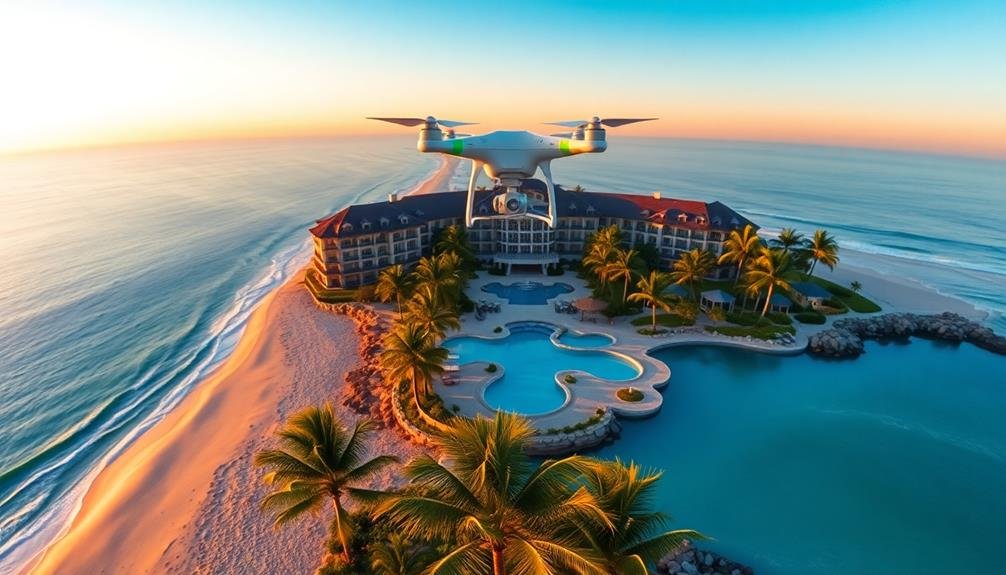
To capture breathtaking drone footage, you'll need to master essential flight techniques.
Start by perfecting smooth panning and tracking movements, which will give your videos a cinematic quality.
You'll also want to focus on altitude control techniques, allowing you to seamlessly adjust your drone's height for dramatic reveals and unique perspectives.
Smooth Panning and Tracking
Smooth panning and tracking are essential skills for capturing stunning drone footage. To master these techniques, you'll need to practice precise control of your drone's movements. Start by flying at a consistent speed and altitude while panning the camera slowly. This creates a cinematic effect that showcases the resort's landscape and architecture.
When tracking subjects, such as guests walking along the beach or boats in the water, maintain a steady distance and match their speed.
To improve your panning and tracking skills:
- Use your drone's intelligent flight modes, like ActiveTrack or Follow Me
- Experiment with different angles and heights for varied perspectives
- Practice flying in figure-eight patterns to refine your control
- Utilize natural features as guides for smooth movements
Remember to adjust your camera settings for ideal results. Slow down your gimbal's rotation speed for smoother pans, and increase your shutter speed to reduce motion blur during tracking shots.
Pay attention to your composition, keeping the horizon level and using the rule of thirds to frame your subjects effectively. With practice, you'll be able to create fluid, professional-looking footage that highlights the resort's best features and captivates viewers.
Altitude Control Techniques
Mastering altitude control is a key component in creating enchanting drone videos. As you navigate the skies above luxury resorts, your ability to adjust and maintain altitude can make or break your footage. Start by practicing smooth ascents and descents, gradually increasing or decreasing altitude to capture sweeping vertical shots.
Experiment with different altitudes to showcase the resort's features. Low-altitude flights can highlight intimate details, while higher altitudes offer breathtaking panoramas. Use the table below to guide your altitude choices:
| Altitude Range | Best For | Challenges |
|---|---|---|
| 0-10 feet | Pool areas, gardens | Obstacle avoidance |
| 10-50 feet | Building exteriors | Wind interference |
| 50-100 feet | Resort layout, beaches | Maintaining stability |
| 100-200 feet | Aerial overviews | Legal height restrictions |
| 200+ feet | Surrounding landscape | Loss of detail |
Remember to maintain a consistent altitude during horizontal movements for smooth footage. When shifting between altitudes, use gentle throttle adjustments to avoid jerky motions. Practice hovering at various heights to perfect your control and capture steady shots of specific resort features. By mastering these altitude control techniques, you'll elevate your drone videos to new heights.
Capturing Aerial Establishing Shots
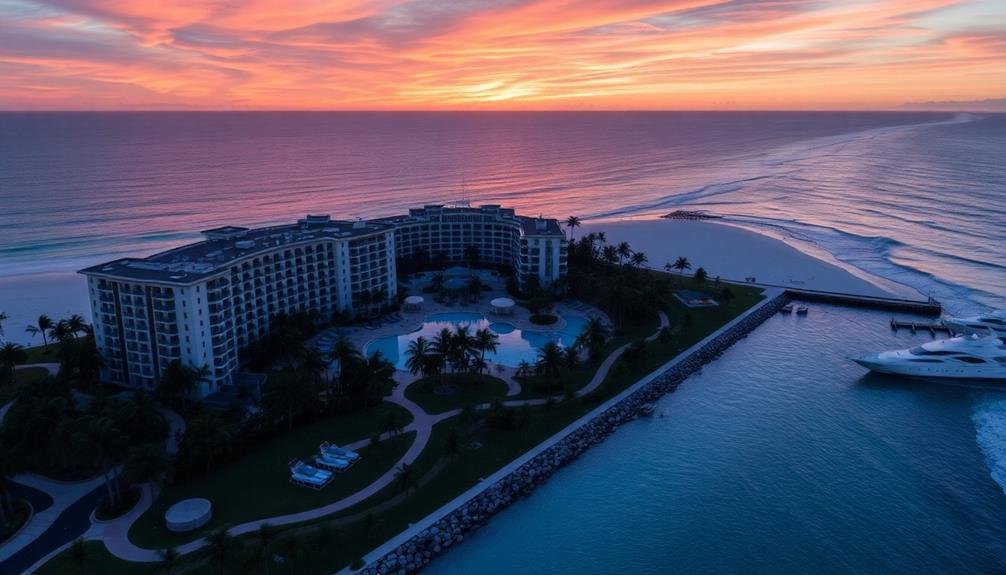
Aerial establishing shots are the crown jewels of drone videography. They provide a breathtaking overview of the resort, setting the stage for the viewer's journey. To capture the perfect establishing shot, start by scouting the location beforehand. Identify key features like the beachfront, main buildings, and unique amenities that define the resort's character.
When you're ready to shoot, begin with a slow, steady ascent to reveal the landscape gradually. This creates a sense of anticipation and allows viewers to orient themselves. As you gain altitude, consider incorporating gentle pans or tilts to showcase the resort's layout and surroundings. Remember to maintain a smooth, controlled flight path to guarantee professional-looking footage.
Experiment with different angles and perspectives to find the most flattering view of the property. Early morning or late afternoon light can add warmth and depth to your shots, enhancing the resort's appeal.
- Fly at various altitudes to capture both wide vistas and intimate details
- Use leading lines, such as roads or coastlines, to guide the viewer's eye
- Incorporate natural elements like nearby mountains or water features
- Showcase the resort's unique selling points, like infinity pools or private beaches
Showcasing Resort Amenities
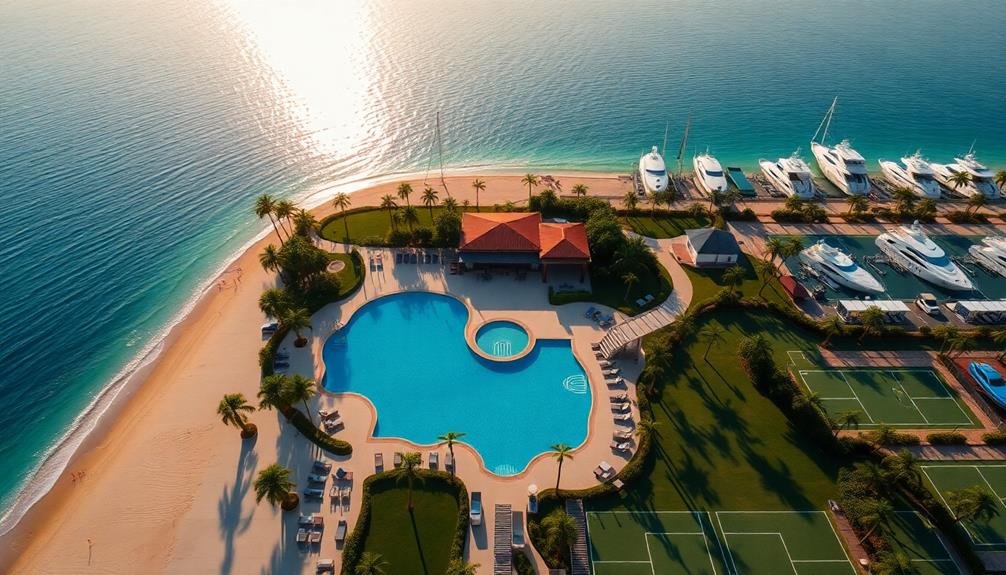
With the establishing shots in place, it's time to highlight the resort's standout features. Focus on capturing the amenities that set this high-end resort apart from others.
Start with the pool area, using slow, sweeping movements to showcase its size and unique design elements. Fly low over the water's surface to create dynamic reflections and ripples.
Next, highlight the spa facilities. Capture the outdoor treatment areas, hot tubs, and relaxation zones from various angles. Use gentle, smooth movements to convey a sense of tranquility.
For indoor amenities like fitness centers or restaurants, fly your drone through open doors or large windows to shift seamlessly between exterior and interior shots.
Don't forget to showcase recreational facilities such as tennis courts, golf courses, or private beaches. Fly at different altitudes to provide context and scale.
For evening shots, capture the resort's lighting design, illuminated pathways, and any water features that come alive at night. Use longer exposure times to create stunning light trails and reflections.
Remember to maintain a consistent flight speed and direction throughout your footage to guarantee smooth shifts between amenities. This will help create a cohesive visual narrative of the resort's offerings.
Highlighting Unique Architectural Features
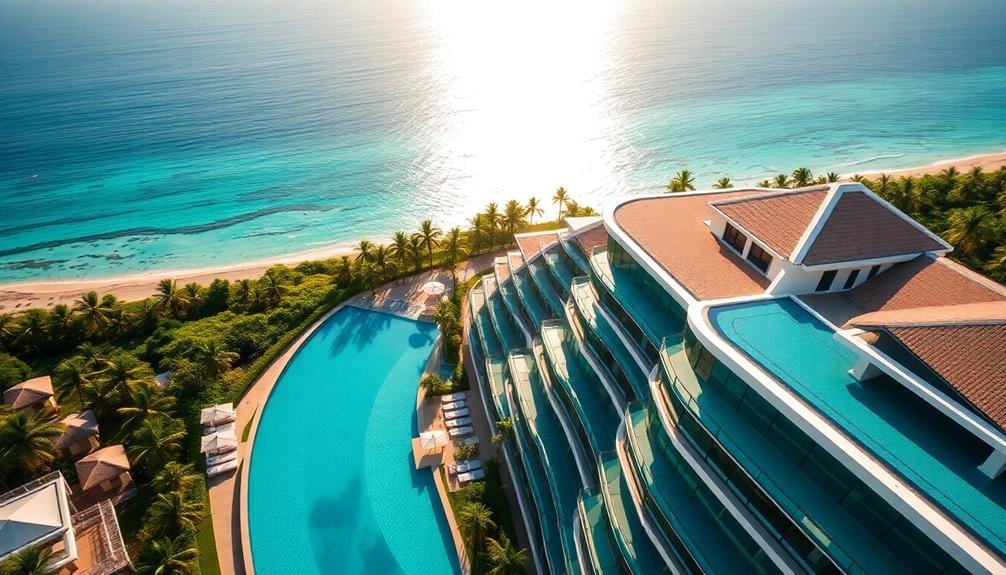
Every resort boasts unique architectural elements that set it apart. Your drone footage should capture these distinctive features to showcase the resort's character. Start by identifying the most striking architectural aspects, such as unusual rooflines, intricate facades, or innovative building shapes.
Plan your flight paths to highlight these elements from various angles and distances. Use slow, sweeping movements to emphasize the grandeur of the architecture. Fly your drone in arcing patterns around tall structures or along the length of sprawling buildings to give viewers a sense of scale.
Don't forget to capture both wide shots that show the entire property and close-ups that reveal intricate details.
Consider these techniques to enhance your architectural drone footage:
- Utilize golden hour lighting to create dramatic shadows and highlight textures
- Incorporate symmetry and leading lines in your compositions
- Contrast modern architectural elements with natural surroundings
- Capture reflections in glass surfaces or water features
Remember to respect privacy and adhere to local drone regulations. By focusing on unique architectural features, you'll create compelling footage that sets the resort apart and entices potential guests to experience its distinctive charm firsthand.
Filming at Different Times
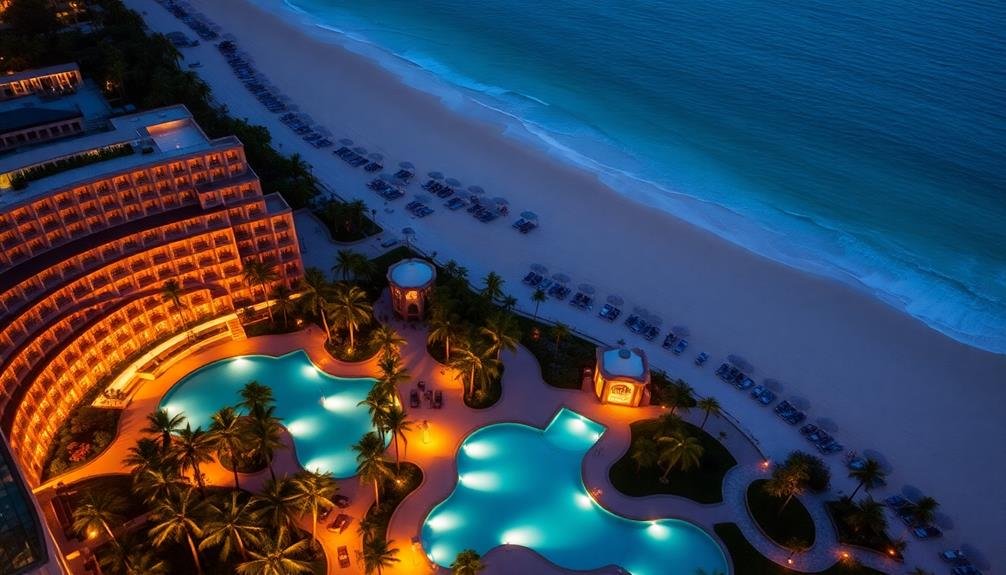
Time of day plays an essential role in capturing stunning drone footage of resorts. You'll want to take advantage of different lighting conditions to showcase the property in its best light.
Start by filming during the golden hour, just after sunrise or before sunset, when the warm, soft light creates a magical atmosphere. This enhances the resort's features and casts long, dramatic shadows.
Don't overlook midday shots, which can be perfect for capturing the vibrant colors of pools, landscaping, and outdoor amenities. The harsh sunlight can create striking contrasts and highlight the resort's architecture.
For a completely different mood, try filming at night. Illuminate pathways, buildings, and water features come alive after dark, creating a romantic and luxurious ambiance.
Consider filming during different seasons to showcase the resort's year-round appeal. Capture lush greenery in spring, sun-soaked beaches in summer, colorful foliage in autumn, and snow-covered landscapes in winter.
Post-Production Editing Tips
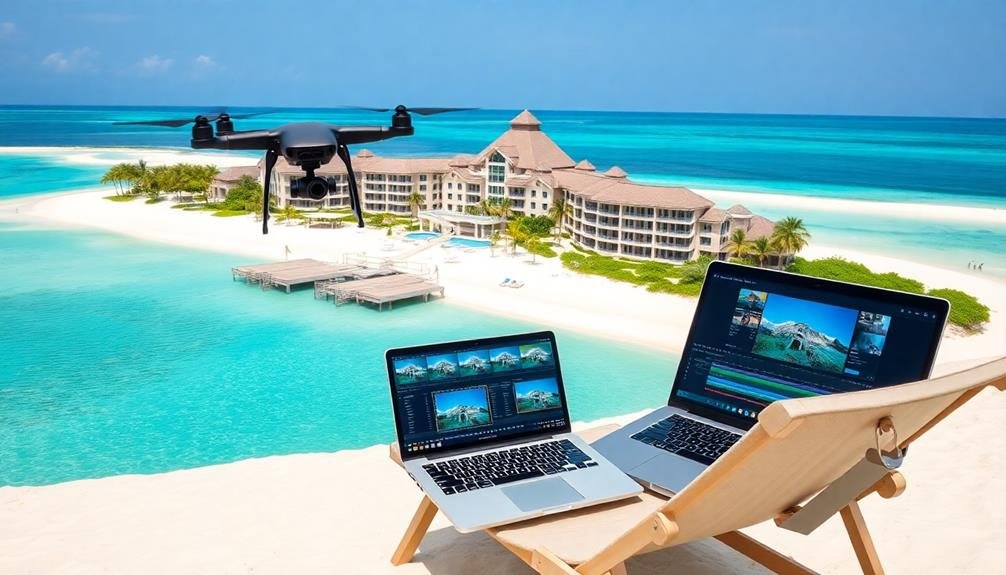
Post-production editing is where your drone footage truly comes to life. It's your chance to transform raw footage into an engaging story that showcases the resort's best features.
Start by organizing your clips and selecting the best shots that highlight the property's unique selling points. Use color grading to enhance the natural beauty of the landscape and create a consistent look throughout your video.
Pay attention to pacing and timing. Combine slow, sweeping shots with faster, dynamic movements to keep viewers engaged. Add smooth transitions between scenes to create a seamless flow.
Don't forget to incorporate audio elements like background music or ambient sounds to enhance the viewing experience.
Consider these key editing techniques:
- Use speed ramping to create dramatic effects
- Experiment with lens flares and light leaks for a cinematic look
- Apply subtle stabilization to smooth out any remaining camera shake
- Create a compelling intro and outro to bookend your video
Color Grading for Luxury Appeal
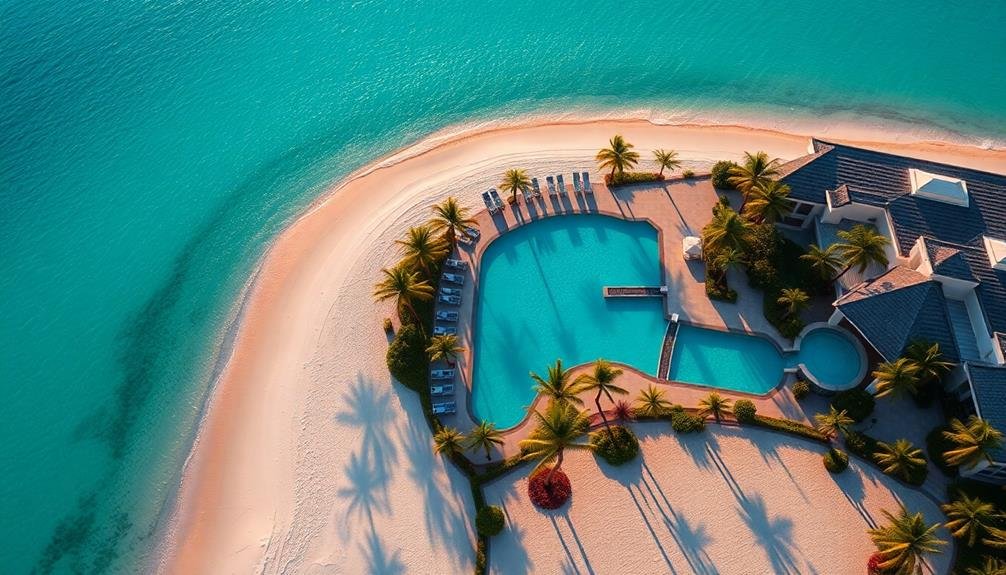
Color grading is a powerful tool that can elevate your drone footage from ordinary to luxurious. When showcasing high-end resorts, you'll want to create a visual aesthetic that exudes opulence and exclusivity.
Start by adjusting the overall tone of your footage to warm, golden hues that evoke a sense of sophistication and comfort. Increase the contrast slightly to make colors pop and add depth to your shots. Boost the saturation of blues and greens to make pools and landscaping appear more vibrant, but be careful not to overdo it.
Enhance the highlights to make sunlit areas gleam, creating a sense of radiance and luxury. For skin tones, aim for a warm, sun-kissed look that's flattering but natural. Adjust the shadows to maintain detail in darker areas without losing the richness of the image.
Consider adding a subtle vignette to draw the viewer's eye to the center of the frame, emphasizing the resort's key features. Experiment with cinematic looks like the orange and teal color palette, which can give your footage a high-end, film-like quality.
Remember to maintain consistency across all your shots to create a cohesive and professional final product.
Delivering the Final Product
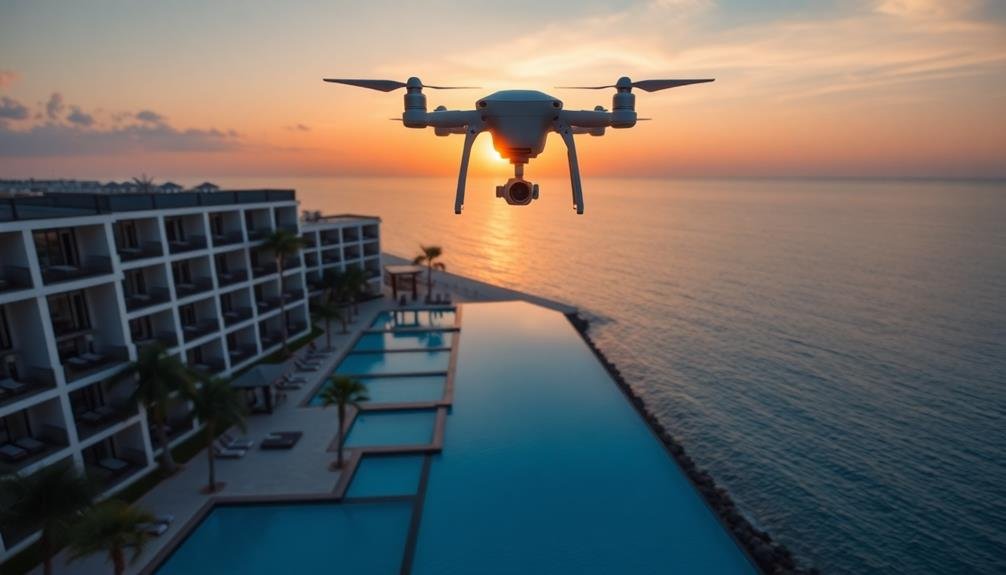
Ultimately, your stunning drone footage deserves a polished delivery that matches its quality. Consider creating a professional showreel that highlights the best shots and sequences from your resort footage. This compilation should tell a compelling visual story, showcasing the property's most impressive features and amenities.
When preparing your final product, pay attention to the following details:
- Format: Guarantee your video is exported in the highest quality possible, using appropriate codecs and resolutions for your client's needs.
- Music: Choose a soundtrack that complements the visuals and enhances the luxurious atmosphere of the resort.
- Titles and graphics: Incorporate subtle, elegant text overlays or animations to provide context or highlight specific areas of the property.
- Branding: Include the resort's logo and any necessary credits in a tasteful manner.
Before delivering the final product, review it carefully for any imperfections or areas that could be improved. Consider sharing a draft with trusted colleagues for feedback.
Once you're satisfied with the result, present the video to your client in a professional manner, explaining your creative choices and how the footage aligns with their marketing goals. Be prepared to make minor adjustments based on their feedback to guarantee complete satisfaction with the end product.
Frequently Asked Questions
How Do I Approach Guests for Consent When Filming in Populated Areas?
You'll need to approach guests politely and explain your filming purpose. Ask for their consent clearly, offering to avoid capturing them if they prefer. Always respect privacy and be prepared to stop filming if requested.
What Insurance Coverage Is Recommended for Professional Resort Drone Videography?
You'll want thorough liability insurance that covers property damage, bodily injury, and privacy violations. Don't forget equipment coverage for your drone. Check if you need additional commercial drone insurance for professional work.
How Can I Minimize Propeller Noise in Drone Footage?
You can minimize propeller noise by using quieter drone models, flying higher, adjusting propellers, and adding noise reduction filters in post-production. Don't forget to use a high-quality external mic for ground audio when needed.
Are There Specific Weather Conditions That Enhance Luxury Resort Drone Videos?
You'll want clear, sunny days with calm winds for the best luxury resort drone videos. Golden hour lighting at sunrise or sunset creates a magical atmosphere. Avoid overcast skies or harsh midday sun for ideal results.
How Do I Negotiate Rates and Contracts for High-End Resort Drone Projects?
You'll want to research market rates, highlight your unique skills, and showcase your portfolio. Be prepared to discuss project details, negotiate usage rights, and offer package deals. Don't undervalue your work; emphasize the value you'll bring.
In Summary
You've now got the tools to create breathtaking drone videos of high-end resorts. Remember, it's all about preparation, creativity, and attention to detail. Don't forget to obtain proper permits, scout locations thoroughly, and plan your shots carefully. With practice, you'll master the art of capturing luxurious landscapes from above. Keep refining your skills in filming and post-production, and you'll soon be producing resort videos that truly stand out and captivate viewers.

As educators and advocates for responsible drone use, we’re committed to sharing our knowledge and expertise with aspiring aerial photographers.




Leave a Reply